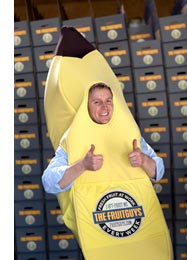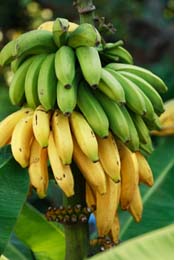Going Bananas
- By Chris Mittelstaedt
- Reading Time: 3 mins.
 Long before I started wearing a banana suit to encourage people to eat more of them, American consumers were instructed in how to peel and eat the famous Cavendish, or sweet, banana: “It is eaten raw, either alone or cut in slices with sugar and cream, or wine and orange juice. It is also roasted, fried or boiled, and is made into fritters, preserves, and marmalades…They are found in our markets from March to October,” reads the entry in the “1878 Domestic Cyclopaedia of Practical Information.”
Long before I started wearing a banana suit to encourage people to eat more of them, American consumers were instructed in how to peel and eat the famous Cavendish, or sweet, banana: “It is eaten raw, either alone or cut in slices with sugar and cream, or wine and orange juice. It is also roasted, fried or boiled, and is made into fritters, preserves, and marmalades…They are found in our markets from March to October,” reads the entry in the “1878 Domestic Cyclopaedia of Practical Information.”
Back then, they were an elusive and probably expensive novelty in the U.S. Today, bananas are the most popular fruit consumed in America, with each person eating an average of 27 pounds of bananas per year.

While they are grown in more than 130 countries, most of the bananas consumed in the U.S. come from Mexico and Central and South America, specifically Costa Rica, Ecuador, Honduras, Guatemala, and Colombia. The banana plant is really an herb that can reach 25 feet high and grows exclusively in tropical and subtropical regions with lots of rain and good soil drainage. They grow on stalks of tightly packed leaves that look like a tree trunk from a large root called a “corm.” They originated in Malaysia. While some bananas are grown in some regions of the U.S., such as Georgia, Florida, Hawaii, and even some specific microclimates in California, there are no “locally grown” bananas of significant volume. While there are many varieties of bananas, the main ones seen in the U.S. are the super popular Cavendish, or sweet banana, and the plantain, or cooking banana.
Banana stalks are harvested and cut into bunches (“hands”) while still green, then shipped to the U.S. Bananas are transported and stored in their green state at around 57°F. They are then exposed to ethylene gas (a harmless plant hormone, both naturally occurring and synthetically produced, used to ripen many vegetables and fruits) in controlled ripening rooms before being distributed to supermarkets.
Want fruit for your office?
Get your office a free sample TODAY!
A banana has seven stages of ripening, from solid green to yellow mottled with brown. Some people may prefer the firm, greener stage, while others like the sweetness of a full yellow or even slightly brown. The FruitGuys considers “5” to be the perfect stage—yellow with green tips. At this stage, the banana is sturdy enough for transport, yet will ripen in a couple of days to a full yellow. If you want to hasten a banana’s ripening, just put it in a bag with a couple of apples. The ethylene gas given off by the apples will cause the banana to ripen faster. It is best not to put bananas in the refrigerator until they are fully ripe. Know that refrigeration will turn the skin black, even if the fruit holds at its previous ripeness.
Bananas are a powerhouse of nutrients. They contain no fat, no cholesterol, and no sodium. A medium-size banana is only about 100 calories and contains 22% RDV of vitamin B6, 17% of vitamin C, 12% fiber, 12% of potassium (an essential body salt lost through sweating), and 10% manganese (needed for healthy bones). After a hard workout, try a banana and a glass of water instead of a sports drink. Bananas act as a natural antacid and are great for soothing upset tummies and acid reflux.
Don’t know what to do with overripe bananas? Use them in a smoothie with nonfat yogurt, ice, and honey. Make banana bread. Peel, slice, and freeze for later use. One of my favorite banana desserts is a caramelized banana.
Get tips for your office
Be an office hero!Enjoy and Be Fruitful! – Chris Mittelstaedt chiefbanana@fruitguys.com


